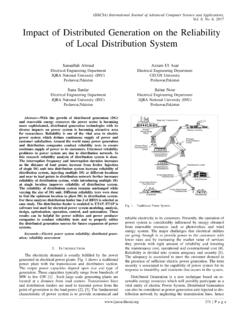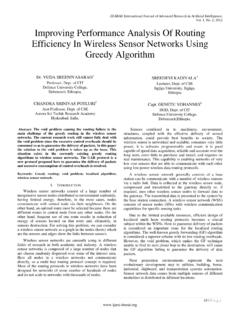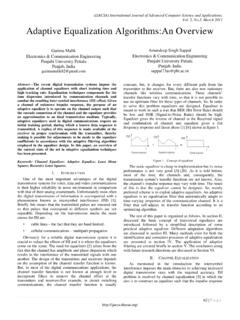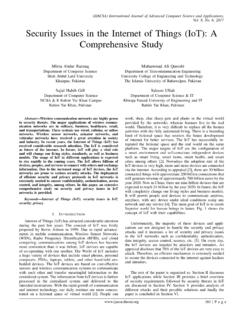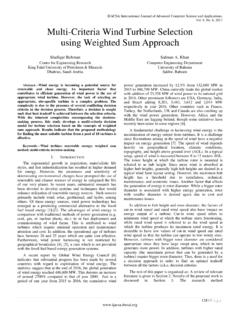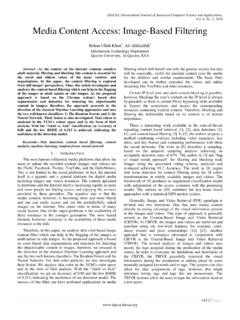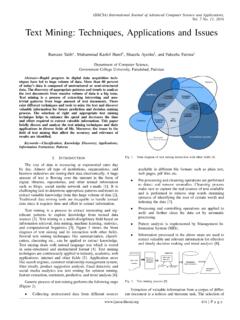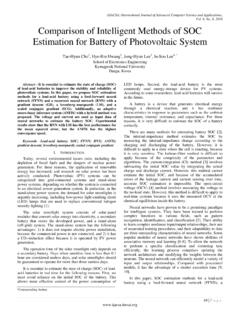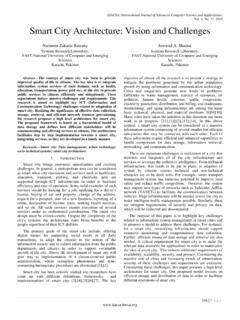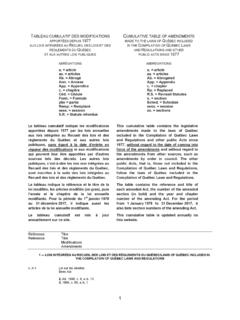Transcription of DUT Verification Through an Efficient and Reusable ...
1 (IJACSA) International Journal of Advanced Computer Science and Applications, Vol. 5, No. 4, 2014 155 | P a g e DUT Verification Through an Efficient and Reusable Environment with Optimum Assertion and Functional Coverage in SystemVerilogDeepika Ahlawat VLSI Group Department of Electrical, Electronics & Communication Engineering, ITM University, Gurgaon, (Haryana), India Neeraj Kr. Shukla VLSI Group Department of Electrical, Electronics & Communication Engineering, ITM University, Gurgaon, (Haryana), India Abstract Verification is the most integral part of chip manufacturing and testing and is as important as the designing. Verification provides with the actual implementation and functionality of a Design under Test (DUT) and checks if it meets the specifications or not. In this paper, a communication protocol has been verified as per the design specifications. The environment so created completely wraps the design under Verification and observes an optimum functional and assertion based coverage.
2 The coverage so obtained is 100% assertion based coverage and functional coverage using SV (SystemVerilog). The total coverage so obtained is Keywords Assertions; Coverage; Environment; Mailbox; Randomization;SystemVerilog; Threads; Transactions I. INTRODUCTION With increasing complexity of the input constraints and the need for better control of the statistical distribution, imperative test benches are being replaced by more declarative specification methods using languages such SystemVerilog [1]. A. Need of Verification Exponentially increasing complexity of chips particularly SOCs made Verification more challenging. Major portion of development time (~70%) of a complex SOC is spent on Verification . Reducing Verification effort or time spent on Verification has a strong impact on Time-to-Market (TTM). In order to satisfy such growing complex Verification needs powerful Verification languages and Verification methodologies are employed [2].
3 In general IP Verification requires in depth Verification with coverage based and constraint random simulation technique, which needs an advanced test bench equipped with various components such as coverage monitors and scoreboards. But if an IP was fully verified before and has a minor design change, it is not necessary to verify all features in detail. A few directed cases and simple checkers might be sufficient [3]. Except for simple cases, the behavioral specification of hardware designs is mostly incomplete, leaving the design s response to many input stimuli undefined. During Verification , unspecified inputs must be excluded from examination to avoid undetermined or spurious erroneous behavior. In a simulation-based Verification setting, the concept of a test bench is applied to specify valid input sequences as well as the expected design responses for them [4]. B. Need of System Verilog SV is built on top of Verilog 2001.
4 SV improves the productivity, readability, and reusability of Verilog based code. It brings a higher level of abstraction to design and Verification . The language enhancements in SV provide more concise hardware descriptions, while still providing an easy route with existing tools into current hardware implementation flows[5]. SV provides a complete Verification environment, employing Directed and Constraint Random Generation, Assertion Based Verification and Coverage Driven Verification . These methods improve the Verification process dramatically. It also provides enhanced hardware-modeling features, which improve the RTL (Register Transfer Level) design productivity and simplify the design process. Advantages of Using SV 1) SV was adopted as a standard by the Accellera organization, and is approval by IEEE. These ensure a wide embracing and support by multiple vendors of EDA (Electronics Design & Automation) tools and Verification IP's, as well as interoperability between different tools and vendors [5].
5 2) Since SV is an extension of the popular Verilog language, the adoption process of SV by engineers is extremely easy and straightforward. SV enables engineers to adopt a modular approach for integrating new modules into any existing code. As a result, the risks and costs of adopting a new Verification language are reduced. 3) Being an integral part of the simulation engine, eliminates the need for external Verification tools and interfaces, and thus ensures optimal performance (running at least x2 faster than with any other Verification languages) [5]. 4) SV brings a higher level of abstraction to the Verilog designer. Constructs and commands like Interfaces, new Data types (logic, int), Enumerated types, Arrays, Hardware-specific always (always_ff, always_comb) and others allow modeling of RTL designs easily, and with less coding.
6 (IJACSA) International Journal of Advanced Computer Science and Applications, Vol. 5, No. 4, 2014 156 | P a g e 5) SV extends the modeling aspects of Verilog by adding a Direct Programming Interface which allows C, C++, SystemC and Verilog code to work together without the overhead of the Verilog PLI (Programmable Logic Interface). A declarative description of input constraints is significantly easier to develop in terms of avoiding over constraining or under constraining the inputs as well as controlling the desired distribution. It is expressed as a predicate on the design s input variables such that an input stimulus is valid if and only if the predicate evaluates to true. Advanced test benches must handle cases in which the validity of an input stimulus may differ from design state to design state, which makes the constraints dependent on state variables [4].
7 The paper is organized as follows, after an overview of Verification and advantages of using SV, section II describes the DUT taken and gives a brief introspection on its working. Section III discusses the test bench architecture and all the components it comprises of. Section IV describes how the SV environment works and the various phases of the test bench. Section V consists of the simulation results in the form of waveforms and the coverage report based on assertion coverage and functional coverage. II. DUT THE SPI CORE The serial interface consists of slave select lines, serial clock lines, as well as input and output data lines. All transfers are full duplex transfers of a programmable number of bits per transfer (up to 64 bits). It can drive data to the output data line in respect to the falling (SPI/Microwire compliant) or rising edge of the serial clock, and it can latch data on an input data line on the rising (SPI/Microwire compliant) or falling edge of a serial clock line [6].
8 Data Transmission The bus master configures the clock first, using a frequency less than or equal to the maximum frequency the slave device supports. Such frequencies are commonly in the range of 10kHz 100 MHz [6]. During each SPI clock cycle, a full duplex data transmission occurs [7]: a) the master sends a bit on the MOSI line; the slave reads it from that same line b) the slave sends a bit on the MISO line; the master reads it from that same line Transmissions may involve any number of clock cycles. When there is no more data to be transmitted, the master stops toggling its clock. Normally, it then deselects the slave. Transmissions often consist of 8-bit words, and a master can initiate multiple such transmissions if it wishes/needs. The master must select only one slave at a time [6]. Fig. 1. SPI Architecture [7] WISHBONE BUS The Wishbone Busis an open source hardware computer bus, intended to allow parallel communication between the parts of an integrated circuit.
9 This System-on-Chip interconnection architecture is used in order to create a common interface between different IP cores. The Wishbone interconnect is intended as a general purpose interface. As such, it defines a master / slave standard for data exchange between IP core modules, in terms of signals, clock cycles, and high & low levels. III. SYSTEMVERILOG TESTBENCH ARCHITECTURE The testbench architecture has various modules as discussed below. The interconnection between these modules can be seen in figure 2. A. Test Generation A Test case is a program block which provides an entry point for the test. The test case generator will provide all the valid test cases to the driver. The test cases are generated by randomizing certain inputs and registers while keeping some fixed. To perform this type of randomization constraint randomization a function called random is created [8].
10 B. Driver The driver will reset and configure the DUT. It will call the tasks from test generator and will form a packet in the packet generator module and will unpack the packet in the driver module and implement it on the DUT. The interfaces of the Driver are: clk_i, rst_i, add_i, data_i, sel_i, we_i, stb_i, cyc_i, sclk, miso. (IJACSA) International Journal of Advanced Computer Science and Applications, Vol. 5, No. 4, 2014 157 | P a g e C. Monitor Monitor will keep track of all the test cases provided to the driver. It will also look at all the signals coming from the DUT. Monitor thus will call the packet in the scoreboard module and compare it with the output from the DUT present in the checker. Hence the duty of monitor is to complete simulation when all cases have been read. It will also generate error message if there is any discrepancy in data out coming from DUT and the teat generator.
